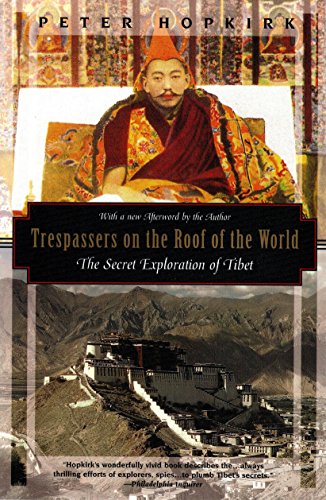
Ebook Info
- Published: 1995
- Number of pages: 286 pages
- Format: PDF
- File Size: 22.02 MB
- Authors: Peter Hopkirk
Description
For nineteenth-century adventures, Tibet was the prize destination, and Lhasa, its capital situated nearly three miles above sea level, was the grandest trophy of all. The lure of this mysterious land, and its strategic importance, made it inevitable that despite the Tibetans’ reluctance to end their isolation, determined travelers from Victorian Britain, Czarist Russia, America, and a half dozen other countries world try to breach the country’s high walls.In this riveting narrative, Peter Hopkirk turns his storytelling skills on the fortune hunters, mystics, mountaineers, and missionaries who tried storming the roof of the world. He also examines how China sought to maintain a presence in Tibet, so that whenever the Great Game ended, Chinese influence would reign supreme. This presence culminated in the Chinese invasion of Tibet in the 1950s, and in a brief afterword, Hopkirk updates his compelling account of “the gatecrashers of Tibet” with a discussion of Tibet today—as a property still claimed and annexed by the Chinese.
User’s Reviews
Editorial Reviews: From Publishers Weekly Hopkirk (The Great Game: The Struggle for Empire in Central Asia) traces international attempts at breaking Tibet’s isolationism since the mid-19th century. Copyright 1995 Reed Business Information, Inc. Review “Hopkirk’s wonderfully vivid book describes the…always thrilling efforts of explorers, spies…to plumb Tibet’s secrets.”—Philadelphia Inquirer”Hopkirk handles the storytelling with infectious enthusiasm…[with] great and obvious love for the subject, and is one of those British writers who cannot write an awkward of boring sentence.”—Bruse Colman, The San Francisco Chronicle”A lament for a country that, wanting only to be left alone, was hauled unceremoniously into the twentieth century, and is now an unwilling satellite of Communist China.”—Richard E. Nicholls, The Philadelphia Inquirer About the Author PETER HOPKIRK is the author of Like Hidden Fire: The Plot to Bring Down the British Empire, Trespassers on the Roof of the World: The Race for Lhasa, and two other books. A staff writer for the Times of London for nineteen years, five as its chief reporter, he is a Middle and Far East specialist. Read more
Reviews from Amazon users which were colected at the time this book was published on the website:
⭐Love Peter Hopkirk’s well written, well researched books. Central Asia comes alive.
⭐Peter Hopkirk does his usual, excellent job chronicling the efforts of Westerners (especially the British) from the 1860’s to the early 20th century to find a way to explore the once forbidden kingdom of Tibet. The colorful cast of characters include men such as Francis Younghusband, Sven Hedin, Nikolai Prejevalski and women such as Dr. Susie Rijnhart and Annie Taylor. Some were military personnel given the mission to make contact with the Tibetans while some were spies recruited and trained by the British government in India to do survey work and collect information on Russian intentions in Central Asia, real or imagined. Others were missionaries such as Dr. Rijnhart (who would pay a terrible price for her efforts) but some were like Henry Savage Landor, adventurers that in his case, needed material for a book and suffered mightily in the process.Although most of the people Hopkirk chronicles in Trespassers on the Roof of the World were motivated by the desire and associated glory of being the first Westerner to reach Lhasa, their tales are not the most interesting, at least in my viewpoint. Mohamed-i-Hameed, Sarat Chandra Das, Kishen Singh, Nain Singh and his cousin Mani, all British spies and often referred to as “pundits”, did much of the early work of opening up Tibet. Their activities were technically illegal and much resented by the Tibetans but their resourcefulness and bravery cannot be questioned and I cannot help but admire them. Hopkirk’s expose’ of their activities is altogether too brief and I hope he is able to write more about them in the future.Sad to say, once the British did reach Lhasa, interest in Tibet slowly faded to the point that when the Tibetans asked western powers for aid in resisting the Chinese annexation of their country in 1950, there was very little done for them. Realpolitik at work, I suppose, but I also think it made many people (especially the Tibetans) wonder what all the fuss among Westerners over Tibet was about in the first place. All in all, Trespassers on the Roof of the World is a great book for anyone interested in learning more about Central Asia’s history and is an entertaining read to boot. I highly recommend it.
⭐This book is so problematic it feels almost immoral not to review it.Sure, it can be entertaining, playing on that whole Adventure in High Asia theme where white (usually British) people treat the rest of the world like it’s their personal playground.The book is written ABOUT the invasions of the late 19th century but is so antiquated in tone and content that it sounds like it WAS written in the late 19th century. Tibetans are always ‘courageous,’ cheerful, innocent, unsuspecting, confused, hearty, and, in a world, Noble Savages. The Europeans are almost always intrepid and cunning, honorable, and stately.Virtually no Tibetan or even non-european sources were used for the book, and almost all the accounts of these Great Gamers are taken at face value, with absolutely no critical commentary provided by the author. He talks about missionaries ‘discovering Tibet,’ the ‘relatively innocent strategic aims of Britain,’ and the barbarity of Tibetan punishments. He almost struggles to say even once that all the people he wrote about were ARMED INVADERS who knew clearly the consequences of their actions.More technically, there is virtually no standardization (or Wylie transliterations) given for Tibetan vocabulary or places, there’s a general lack of understanding of the region(s), and either an ignorance or disingenuousness that runs throughout the book. For example, Hopkirk says that the ‘traveller’ who learned Tibetan while living at Kumbum was held up 2 days outside of Lhasa in negotiations and impressed everyone he met with his uncanny language ability. But anyone who knows anything about this world knows that any Tibetan you are learning around Kumbum would be virtually unintelligible to anyone in Lhasa (unless you are talking about strictly religious/philosophical issues)! This is one of many similar errors – where storytelling convenience blatantly overrides quality or scholarship or reality.If you are going to read this book, I say read it alongside Said’s Orientalism. It will provide a ready-made example to most everything wrong with Europeans propensity to represent Asians. Hopkirk clearly holds authors like Kipling as his role models. That Hopkirk’s writing is virtually as orientalist should have sent up some red flags.If you desire any real scholarship about Tibet, do not waste your time with this book.There is one use for this book and that is as a glossary. Compiled here are quite a few names, missions, places, medals, etc that make for a good collection of late 19th century ‘travelers’ to Tibet. I’ve read an awful lot about Tibet (and lived there) and there are still a good handful of personalities I read about for the first time in this book.
⭐The book’s revelations about Tibet, its striving for independence despite it being both backward and apart from the world in most ways is reminiscent of the American Indians. Thinking about the story’s beginnings, it is both interesting and sad (for Tibet and its explorers) how events have scarred the nation.
⭐When it comes to delineating the history of Central Asia and environs, few writers can touch the craftsmanship of author Peter Hopkirk. In his hands, what could easily be boring history, becomes, instead, vibrant excitement. As in his other books, Hopkirk makes these mysterious and fabled lands come alive. In this book he describes the many attempts by adventurers from the outside world to penetrate remote Tibet and its almost-mystical capital, Lhasa. Chapter by chapter Hopkirk ticks off the sagas of these opportunists, some seeking fortune and fame, some on their majesty’s (or tsar’s) service. In the contest between Tibet versus the world, Tibet scores early and frequently, thus keeping the others out. But eventually, overpowered by modern weaponry, the outsiders win. It’s tempting to cast this in terms of good-guys versus bad-guys. But it’s not that easy, as the reader will see. What IS easy is declaring this book a fantastic and exciting history of a mysterious land that just wanted to be left alone.
Keywords
Free Download Trespassers on the Roof of the World: The Secret Exploration of Tibet (Kodansha Globe) in PDF format
Trespassers on the Roof of the World: The Secret Exploration of Tibet (Kodansha Globe) PDF Free Download
Download Trespassers on the Roof of the World: The Secret Exploration of Tibet (Kodansha Globe) 1995 PDF Free
Trespassers on the Roof of the World: The Secret Exploration of Tibet (Kodansha Globe) 1995 PDF Free Download
Download Trespassers on the Roof of the World: The Secret Exploration of Tibet (Kodansha Globe) PDF
Free Download Ebook Trespassers on the Roof of the World: The Secret Exploration of Tibet (Kodansha Globe)



